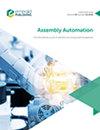Fast and accurate detection of surface defect based on improved YOLOv4
IF 1.7
4区 计算机科学
Q3 AUTOMATION & CONTROL SYSTEMS
引用次数: 2
Abstract
Purpose The current popular image processing technologies based on convolutional neural network have the characteristics of large computation, high storage cost and low accuracy for tiny defect detection, which is contrary to the high real-time and accuracy, limited computing resources and storage required by industrial applications. Therefore, an improved YOLOv4 named as YOLOv4-Defect is proposed aim to solve the above problems. Design/methodology/approach On the one hand, this study performs multi-dimensional compression processing on the feature extraction network of YOLOv4 to simplify the model and improve the feature extraction ability of the model through knowledge distillation. On the other hand, a prediction scale with more detailed receptive field is added to optimize the model structure, which can improve the detection performance for tiny defects. Findings The effectiveness of the method is verified by public data sets NEU-CLS and DAGM 2007, and the steel ingot data set collected in the actual industrial field. The experimental results demonstrated that the proposed YOLOv4-Defect method can greatly improve the recognition efficiency and accuracy and reduce the size and computation consumption of the model. Originality/value This paper proposed an improved YOLOv4 named as YOLOv4-Defect for the detection of surface defect, which is conducive to application in various industrial scenarios with limited storage and computing resources, and meets the requirements of high real-time and precision.基于改进YOLOv4的表面缺陷快速准确检测
目前流行的基于卷积神经网络的图像处理技术具有计算量大、存储成本高、微小缺陷检测精度低的特点,与工业应用要求的实时性和准确性高、计算资源和存储空间有限的要求相悖。因此,针对上述问题,提出了一种改进型的YOLOv4,命名为YOLOv4- defect。设计/方法/途径本研究一方面对YOLOv4的特征提取网络进行多维压缩处理,简化模型,通过知识蒸馏提高模型的特征提取能力。另一方面,通过加入更细致的感受场预测尺度来优化模型结构,提高了对微小缺陷的检测性能。结果通过公共数据集NEU-CLS和DAGM 2007以及实际工业现场的钢锭数据集验证了该方法的有效性。实验结果表明,提出的YOLOv4-Defect方法可以大大提高识别效率和准确率,减小模型的尺寸和计算量。独创性/价值本文提出了一种改进的YOLOv4,命名为YOLOv4- defect,用于表面缺陷的检测,有利于在存储和计算资源有限的各种工业场景中应用,满足高实时性和精度的要求。
本文章由计算机程序翻译,如有差异,请以英文原文为准。
求助全文
约1分钟内获得全文
求助全文
来源期刊

Assembly Automation
工程技术-工程:制造
CiteScore
4.30
自引率
14.30%
发文量
51
审稿时长
3.3 months
期刊介绍:
Assembly Automation publishes peer reviewed research articles, technology reviews and specially commissioned case studies. Each issue includes high quality content covering all aspects of assembly technology and automation, and reflecting the most interesting and strategically important research and development activities from around the world. Because of this, readers can stay at the very forefront of industry developments.
All research articles undergo rigorous double-blind peer review, and the journal’s policy of not publishing work that has only been tested in simulation means that only the very best and most practical research articles are included. This ensures that the material that is published has real relevance and value for commercial manufacturing and research organizations.
 求助内容:
求助内容: 应助结果提醒方式:
应助结果提醒方式:


